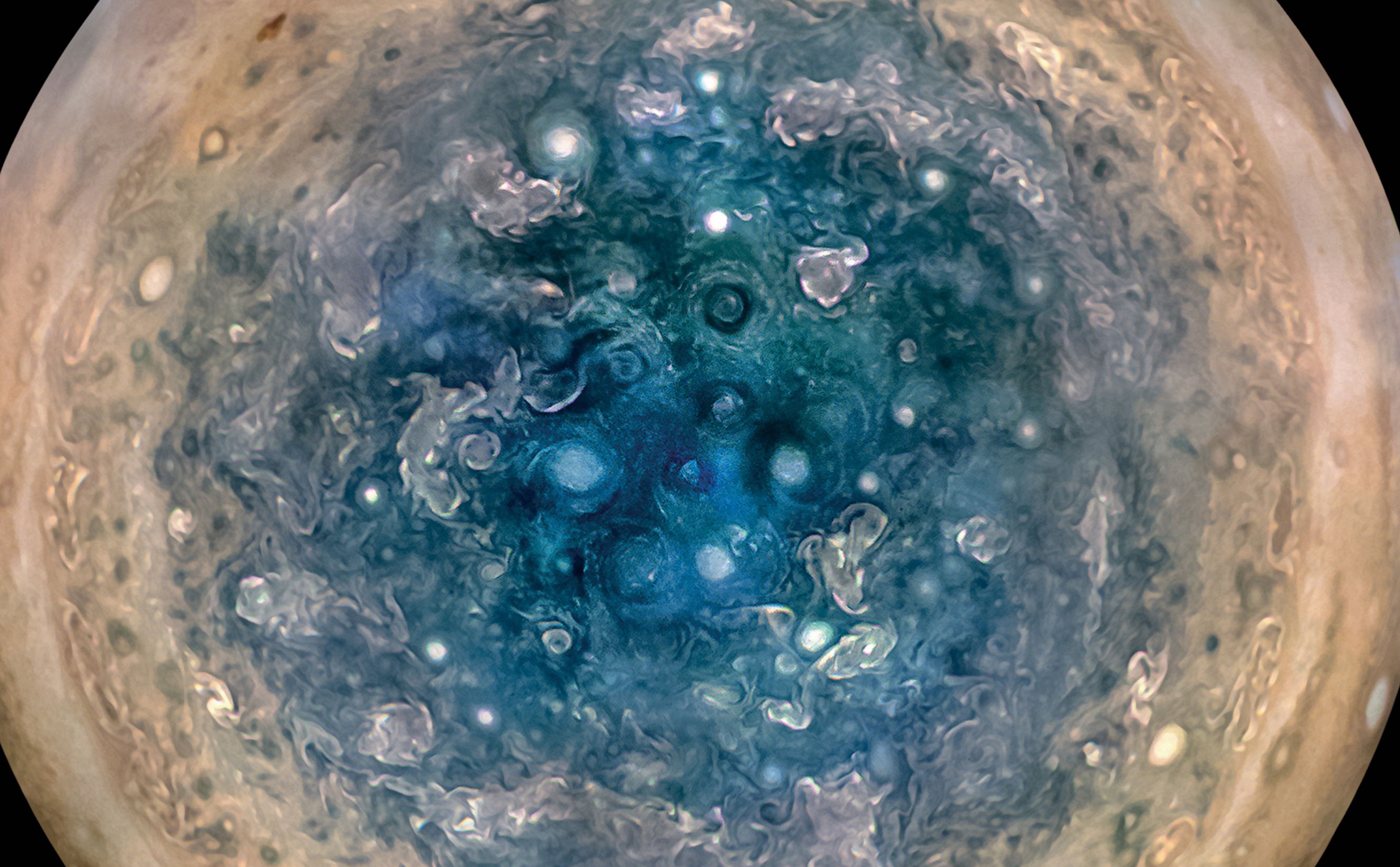Moist convection at Jovian high latitudes
 Jupiter’s south pole © NASA/JPL-Caltech
Jupiter’s south pole © NASA/JPL-Caltech
Jupiter’s atmosphere is one of the most turbulent places in the solar system. Lightning and thunderstorm observations point to moist convection as a small-scale energy source for Jupiter’s large-scale vortices and zonal jets, yet it has never been demonstrated due to the coarse resolution of pre-Juno measurements. Since 2017, the Juno spacecraft discovered that Jovian high-latitudes host a cluster of large cyclones (diameter of ~ 5,000 km each) associated with intermediate (~ 1,600-500 km) and smaller-scale vortices and filaments (~ 100 km).
Here, we analyze Juno-infrared images with an unprecedented high-resolution of 10 km. We unveil a new dynamical regime associated with a significant energy source of convective origin that peaks at 100 km-scales and in which energy gets subsequently transferred upscale to the large circumpolar and polar cyclones. While this energy route has never been observed on another planet, it is surprisingly consistent with idealized studies of rapidly rotating Rayleigh-Bénard convection, lending robust theoretical support to our analyses. This energy route may also be relevant to the Earth’s atmosphere, helping us better understand the dynamics of our own planet.

Jupiter’s north pole taken by JIRAM (ASI) onboard JUNO © NASA/JPL-Caltech
References
Siegelman, L., Klein, P., Ingersoll, A.P., Ewald, S.P., Young, W.R., Bracco, A., Adriani, A., Grassi, D., Plainaki, C., & Sindoni, G (2022). Moist convection drives an upscale energy transfer at Jovian high latitudes. Nature Physics [doi, pdf]
Ingersoll, A.P., Ewald, S.P., Adriani, A., Grassi, D., Mura, A., Plainaki, C., Sindoni, G., Tossi, F., Li, C., Siegelman, L., Klein, P. & Young, W.R. (in press). Polygonal patterns of vortices on Jupiter: Convective forcing and large-scale shielding. Nature Astronomy [preprint]
Polar vortex crystals
Siegelman, L., Klein, P., Ingersoll, A.P., Ewald, S.P., Young, W.R., Bracco, A., Adriani, A., Grassi, D., Plainaki, C., & Sindoni, G (2022). Moist convection drives an upscale energy transfer at Jovian high latitudes. Nature Physics [doi, pdf]
Ingersoll, A.P., Ewald, S.P., Adriani, A., Grassi, D., Mura, A., Plainaki, C., Sindoni, G., Tossi, F., Li, C., Siegelman, L., Klein, P. & Young, W.R. (in press). Polygonal patterns of vortices on Jupiter: Convective forcing and large-scale shielding. Nature Astronomy [preprint]
Polar vortex crystals
This movie shows the formation and persistence of a polar vortex crystal with a moderate temporal resolution of 8 hours over 8 years. The circle of radius Lγ, characterizing the size of the crystal, is shown in black.
Vortex crystals are quasiregular arrays of like-signed vortices in solid-body rotation embedded within a uniform background of weaker vorticity. Vortex crystals are observed at the poles of Jupiter and in laboratory experiments with magnetized electron plasmas in axisymmetric geometries. We show that vortex crystals form from the free evolution of randomly excited two-dimensional turbulence on an idealized polar-cap. Once formed, the crystals are long-lived and survive until the end of the simulations (300 crystal-rotation periods). We identify a fundamental length scale, Lγ = (U/γ)1/3, characterizing the size of the crystal in terms of the mean square velocity U of the fluid and the polar parameter γ = fp / ap2, with fp the Coriolis parameter at the pole and ap the polar radius of the planet.
This movie shows the first 1.4 years of formation of the same polar vortex crystal with a high temporal resolution of 60 sec.